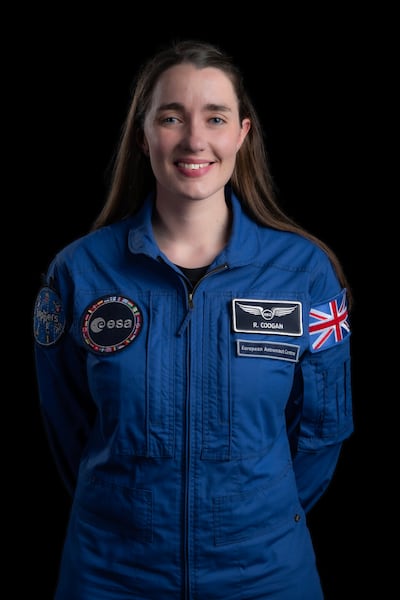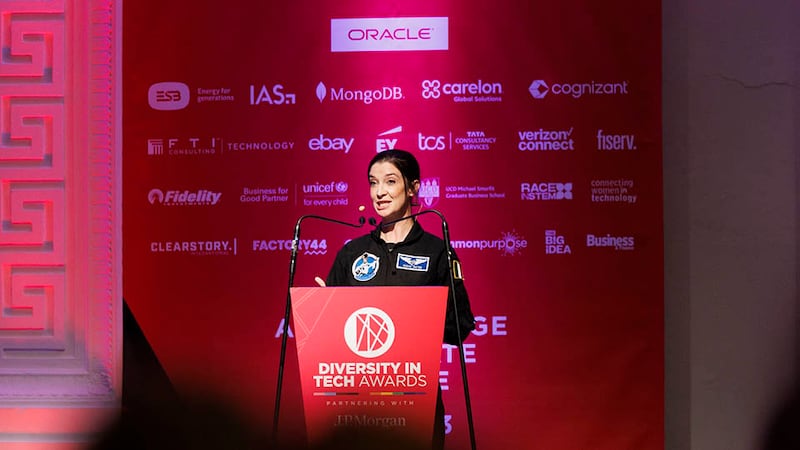The seven astronauts currently aboard the International Space Station orbiting above us have one big health issue in common with post-menopausal women down here. It is the challenge of accelerated muscle and bone loss.
In the microgravity of space it is called “skeletal unloading” and is significantly more rapid. Astronauts can lose up to 1 or 2 per cent of bone density per month in the hip and spine, according to Nasa. (Around the time of menopause, women can lose 2 per cent or more of bone per year.) “This rapid bone loss can place the crew members at risk for bone fracture and risk of early-onset osteoporosis [a bone deterioration disorder],” notes the US space agency.
The changes space makes to your body and how to counteract these is of huge interest to Irish doctor Lisa McNamee, co-founder of Space Medicine Ireland. She has completed the European Space Agency’s space physician training course and a University of Texas principles of aviation and space medicine course and is working on several space medicine research projects. So what is space medicine?
“Basically, it’s the preparation of astronauts for flight,” says the 38-year-old, sitting in the alumni meeting room in Trinity College Dublin, where she studied classics and French, before later doing the postgraduate course in medicine at the Royal College of Surgeons in Ireland (RCSI). “It’s the maintenance of their health while they’re in flight and it’s the rehabilitation after flight.”
However, there is much more to this field than being a doctor to the astronauts, which is clearly a limited speciality. It also involves applying knowledge gained through space travel to improve terrestrial medical treatments. These learnings come not just from enabling astronauts to remain physically and mentally well in space but also from extensive research projects conducted in microgravity, such as drug testing, ageing experiments, wound healing and medtech work.
Widely used finger pulse oximeters, which measure the oxygen saturation level of blood, are just one example, she says, of a spin-off from the “travel light” imperative to miniaturise devices used in space, which then become cheaper to produce here. Use of sensors, developed for remote medical monitoring of astronauts’ health, is an accelerating trend in general medicine.
As people travel further and spend longer in space, the health challenges intensify. Plans for new cosmic frontiers include the 2027 launch of Gateway, a space station to orbit around the moon and, it is hoped, to pave the way for establishing a base on the Moon. To put that into context, the International Space Station (ISS) travels around Earth about 400km above us, whereas the nearest the Moon ever gets to this planet on its elliptical orbit is 363,000km. From the Moon, the next space destination for humankind will be Mars, about 225,000,000km away and a round trip of up to three years.
When you first go into microgravity, you get a kind of a shock to the system .. There’s no shame in getting space sick. There is shame in missing the bag
Meanwhile, space tourism, which is gathering pace, brings its own health issues. Traditionally, astronauts are handpicked through lengthy, rigorous physical and mental health screenings. With ability to pay being a new prerequisite for a seat on a commercial rocket, where can an ethical line be drawn on fitness standards?
“Exercise countermeasures” is the current focus for Dr McNamee, who won the Women in Stem Rising Star of the Year award in October. These are “anything that you do to mitigate or to push back the effects of space on the human body, because we’re not designed for space, we’ve evolved here. We’re designed to be functional at this gravity.” She will give a free talk (to book, see eventbrite.com) titled How Space Spooks your Skeleton on November 7th as part of the annual Samhain agus Science festival hosted by the Dublin Institute for Advanced Studies (DIAS) at Burlington Road, Dublin 4, which runs until November 12th.
ISS crew members are required to do workouts every day in an effort to minimise muscle wasting and bone loss. The weightlessness they experience means there is no pressure on the muscles, which start to wither through lack of use. This affects not just the limbs but also the heart, a muscular organ that pumps blood around the body.
In addition, bone mass starts to reduce due to lack of muscle-bone interactions. People tend to think of bones as fixed substances, she says, but they are living tissue that is very responsive to muscle tension and muscles working on them.
“If they don’t have that, they thin, in two ways. They stop making new bone, which they’re doing all the time, but also they start reabsorbing bone that is already there.” To minimise the impact of this in space, only people with very good bone density are selected to be astronauts, but they are also required to do weight-bearing as well as cardiovascular exercise during daily two-hour workouts.
Think of how expensive it is to train an astronaut and send them into space, says Dr McNamee. The fact that they are required to spend two hours every single day just on exercise shows what a priority it is for Nasa and the European Space Agency (ESA). Although most of what we see of ISS crew members is chatting on video-links or posting on social media, the bulk of their time up there is spent conducting research experiments under close direction
The ISS is larger than a six-bedroom house, with six sleeping quarters, two bathrooms, a gym and a 360-degree view bay window. In the gym there is a treadmill, an ergometer bike and an advanced resistive exercise device.

“Astronauts are strapped in to this device so that they can do jogging, weight-bearing exercise and they can actually lift weights. Obviously if you were to lift weights in microgravity you’d lift it and then the momentum of you lifting your arm with the heavy weight would keep you moving. So it would be absolutely no value to your muscles. You have to have this system whereby you’re strapped in and everything is working against you.”
All the major space agencies are trying to find new ways to reduce, halt or reverse this bone loss, says McNamee. This should have spin-off benefits for the rest of us.
There are an estimated 300,000 men and women in Ireland with osteoporosis. As a society we don’t have a great understanding of the things that keeps our bones healthy, she suggests, and, traditionally, women’s health has been a neglected area. It is estimated half of all women in Ireland aged over 50 will suffer a fracture due to osteoporosis, and 25 per cent of older men are likely to be similarly affected. There is up to a one-in-three chance of dying within one year of a hip fracture.
“Weight-bearing exercise as a preventer is something that we should be encouraging, prescribing,” she says.
Nasa and ESA conduct bed rest studies to give researchers insights into how humans adapt to weightlessness. Volunteers spend anything between five and 60 days in a bed tilted toward the head end, and are not allowed to stand up unless a particular experiment requires it. Their bodies start to adapt, as if in space. Research findings allow measures to be devised that will help astronauts on space missions – as well as bedridden people recuperating from illness.
Bone loss in space varies from person to person, which is another interesting aspect for research, she notes. On return to Earth, astronauts start individualised, targeted rehabilitation exercise programmes under supervision. “It’s kind of a graduated return to 1G [normal gravity] exercise.”
Altered gravity is one of the big five health hazards in space flight, she explains, along with isolation and confinement, distance from Earth, radiation and the alien environment.
In addition to muscle and bone issues, microgravity also causes a fluid shift in the body, typically giving astronauts puffy faces and skinny “chicken” legs. This redistribution of fluid in the body causes pressure to build at the back of the eye resulting in space associated neuro-ocular syndrome.
“It’s not something that they fully understand.” It can lead to blurring of vision when astronauts first go up and for some it may persist.
“When you first go into microgravity, you get a kind of a shock to the system,” says Dr McNamee. “This can cause space sickness but does not necessarily affect people who suffer motion sickness, so it is difficult to predict.” Each astronaut is issued with sick bags and anti-emetic medication. “There’s no shame in getting space sick. There is shame in missing the bag ...”
Dr McNamee, mother of a three-year-old daughter, sparkles with enthusiasm as she talks about space travel, which has fascinated her since her childhood days in Co Meath. She is delighted to see the growth of space-active industry in Ireland, with the national space strategy for enterprise’s target of 100 companies engaging with the ESA by 2025 having been reached by January of this year. “I was really into sci-fi when I was a kid.”
[ How Ireland is building a strong reputation in Europe’s space programmeOpens in new window ]
Her father was a helicopter pilot and engineer and she recalls a family trip to the Air and Space Museum in Washington DC, while visiting their uncle over there. “It was like a defining experience.”
Currently a commandant with the Irish Defence Forces at St Bricin’s military hospital in Dublin 7, she points out that learnings from military teams, the airline industry and space industry all feed into each other when it comes to managing error, safety and conflict among personnel.
“There’s a reason why a lot of astronauts are pilots or were pilots, because it’s the same sort of check-and-test, check-and-test mindset ... egos at the door.”
They need to be psychologically prepared for danger. “Space is hard, it’s risky and it doesn’t always work out,” she says, referring to the loss of the space shuttles Challenger, 73 seconds after its launch in 1986, and Columbia on re-entering Earth’s atmosphere in 2003, with a total of 14 astronauts killed.
She did apply for ESA’s most recent round of astronaut selection “not with great hope but I think I would have kicked myself if I hadn’t”.

The new class of 17 astronaut candidates announced in November 2022, including Belfast-born astrophysicist Rosemary Coogan, were selected from a pool of more than 22,500 applicants across Europe.
Meanwhile, aeronautical engineer Dr Norah Patten from Ballina, Co Mayo is set to become Ireland’s first person in space. Working with the International Institute for Astronautical Sciences, she has been selected for a commercial, Virgin Galactic, suborbital research flight. She is expecting to go within 12 months of the planned 2026 launch of Virgin’s new ship and will conduct experiments during the two-hour flight.

[ Meet the Irish women aiming to become space trailblazersOpens in new window ]
Dr McNamee is in the process of submitting research experiments for Virgin Galactic, which she is hoping will be approved. She is working with Dr Aamir Hameed of the RCSI on a cardiology project relating to the fact that as the suborbital flight business grows, many of the passengers will be older and more likely to have heart issues.
“We’re trying to develop safety standards for certain medical conditions. Are they safe to fly or not?”
With space tourism being a niche market, McNamee looks to the “downstream” effects of space research for medicine in general. “I think quite a few of the applications from space have the potential to benefit a lot of people, which is what I find most interesting.”
- Sign up for push alerts and have the best news, analysis and comment delivered directly to your phone
- Join The Irish Times on WhatsApp and stay up to date
- Listen to our Inside Politics podcast for the best political chat and analysis


















